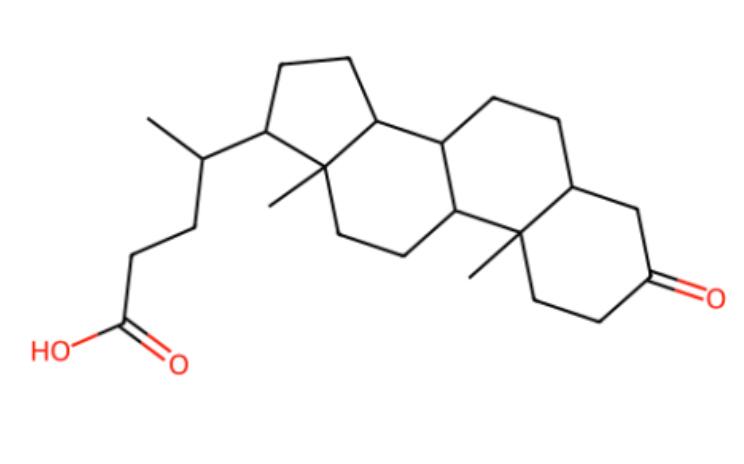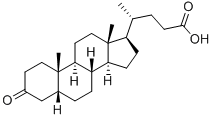3-氧代-5β-胆烷酸,3-Oxo-5β-cholanoic Acid,≥98%
产品编号:西域试剂-WR123149| CAS NO:1553-56-6| MDL NO:MFCD00046265| 分子式:C24H38O3| 分子量:374.57
3-Oxo-5β-cholanoic acid (Dehydrolithocholic acid),胆汁酸代谢产物,通过直接与关键转录因子RORγt (Kd=1.13 μM) 结合抑制 TH17 细胞分化。
本网站销售的所有产品仅用于工业应用或者科学研究等非医疗目的,不可用于人类或动物的临床诊断或者治疗,非药用,非食用,
| 英文名称 | 3-Oxo-5β-cholanoic Acid | ||||||||||||||||
|---|---|---|---|---|---|---|---|---|---|---|---|---|---|---|---|---|---|
| CAS编号 | 1553-56-6 | ||||||||||||||||
| 产品描述 | 3-Oxo-5β-cholanoic acid (Dehydrolithocholic acid),胆汁酸代谢产物,通过直接与关键转录因子RORγt (Kd=1.13 μM) 结合抑制 TH17 细胞分化。 | ||||||||||||||||
| 产品熔点 | 135-139° C | ||||||||||||||||
| 外观性状 | 固体 | ||||||||||||||||
| 溶解性 | DMF: 30 mg/ml,DMF:PBS (pH 7.2) (1:4): 0.20 mg/ml,DMSO: 15 mg/ml,Ethanol: 10 mg/ml | ||||||||||||||||
| 溶解性数据 | In Vitro: DMSO 中的溶解度 : 100 mg/mL (266.98 mM; 超声助溶; 吸湿的 DMSO 对产品的溶解度有显著影响,请使用新开封的 DMSO) H2O 中的溶解度 : < 0.1 mg/mL (insoluble) 配制储备液
* 请根据产品在不同溶剂中的溶解度选择合适的溶剂配制储备液;一旦配成溶液,请分装保存,避免反复冻融造成的产品失效。 In Vivo: 请根据您的 实验动物和给药方式 选择适当的溶解方案。 以下溶解方案都请先按照 In Vitro 方式配制澄清的储备液,再依次添加助溶剂:
该产品建议参考如下动物实验溶解方案,可直接配制工作。建议现用现配,在短期内尽快用完。 以下溶剂前显示的百分比是指该溶剂在您配制终溶液中的体积占比; 如在配制过程中出现沉淀、析出现象,可以通过加热和/或超声的方式助溶。
| ||||||||||||||||
| 储存条件 | 储存条件: -20°C 运输方式: 冰袋运输,根据产品的不同,可能会有相应调整。 |
相关文档
化学品安全说明书(MSDS)
下载MSDS质检证书(COA)
相关产品
[1].Deo, A.K., and Bandiera, S.M.3-Ketocholanoic acid is the major in vitro human hepatic microsomal metabolite of lithocholic acidDrug Metab. Dispos.37(9)1938-1947(2009)
[2].Sato, H., Macchiarulo, A., Thomas, C., et al.Novel potent and selective bile acid derivatives as TGR5 agonists: Biological screening, structure-activity relationships, and molecular modeling studiesJ. Med. Chem.51(6)1831-1841(2008)
[3].Makishima, M., Lu, T.T., Xie, W., et al.Vitamin D receptor as an intestinal bile acid sensorScience296(5571)1313-1316(2002)
[4].Staudinger, J.L., Goodwin, B., Jones, S.A., et al.The nuclear receptor PXR is a lithocholic acid sensor that protects against liver toxicityProc. Natl. Acad. Sci. USA98(6)3369-3374(2000)
[5].Hang, S., Paik, D., Yao, L., et al.Bile acid metabolites control TH17 and Treg cell differentiationNature576(7785)143-148(2019)









 浙公网安备 33010802013016号
浙公网安备 33010802013016号